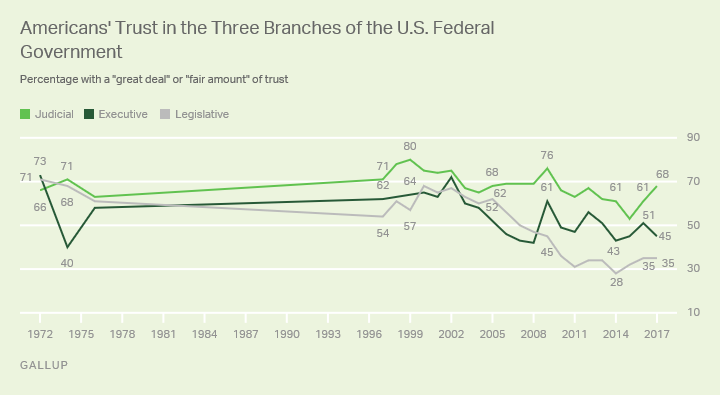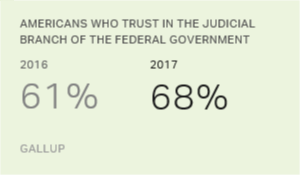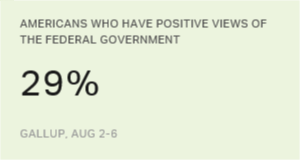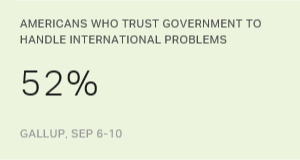Story Highlights
- Trust in judicial up from 61% to 68%
- 45% trust executive branch, down from 51% a year ago
- No change in trust in the legislative branch
This story is part of a series focusing on Americans' confidence in various types of government, views of the political parties and of the role and power of government. Follow the series on our government topic page.
WASHINGTON, D.C. -- Americans are more trusting now than they were a year ago in the judicial branch of the federal government, while they have less trust in the executive branch, and their trust in the legislative branch has not changed. As is typically the case, Americans place the greatest faith in the judicial branch and the least in the legislative.

The current results are based on Gallup's annual Governance poll, conducted Sept. 6-10. They point to a continued rebound in Americans' trust in the judicial branch since 2015, when the percentage of Americans with a "great deal" or "fair amount" of trust fell to a record-low 53%. Today's 68% is back to the historical average in Gallup readings since 1972, including annual measurements since 1997.
Meanwhile, the 35% of Americans who trust the legislative branch remains improved from its low point of 28% in 2014, but the positive momentum has apparently stalled given no increase in the past year. Trust in the legislative branch remains well below the historical average of 51% since 1972.
Americans' trust in the executive branch, now overseen by President Donald Trump, fell back to 45% this year after improving to 51% in 2016, President Barack Obama's last year in office. The current level of trust in the executive branch is similar to what it was in 2014 (43%) and 2015 (45%).
The historical low point in trust in the executive branch was 40% in April 1974 amid the Watergate crisis, but there have been several other readings below 50% since then, including three times under President George W. Bush (2006-2008), four times under Obama (2010-2011 and 2014-2015), and this year. The average level of trust in the executive branch is 55%.
Trust in the three branches collectively remains below average from a historical perspective. Americans were most trusting of the three branches prior to Watergate and in the late 1990s and early 2000s likely because of a strong economy and the rally effects of the 9/11 terror attacks.
Republicans Lead Increase in Judicial Trust
With conservative Justice Neil Gorsuch joining the Supreme Court in April, Republicans' trust in the judicial branch has surged over the past year, from 48% in September 2016 to 79% today. Democrats are now less trusting in the federal judiciary (62%) than they were a year ago (74%), while there has been no meaningful change among independents. The overall increase in trust in the judicial branch is largely driven by the shift in Republican attitudes, which more than offsets the smaller Democratic decline.
| 2016 | 2017 | Change | |||||||||||||||||||||||||||||||||||||||||||||||||||||||||||||||||||||||||||||||||||||||||||||||||
|---|---|---|---|---|---|---|---|---|---|---|---|---|---|---|---|---|---|---|---|---|---|---|---|---|---|---|---|---|---|---|---|---|---|---|---|---|---|---|---|---|---|---|---|---|---|---|---|---|---|---|---|---|---|---|---|---|---|---|---|---|---|---|---|---|---|---|---|---|---|---|---|---|---|---|---|---|---|---|---|---|---|---|---|---|---|---|---|---|---|---|---|---|---|---|---|---|---|---|---|
| % | % | pct. pts. | |||||||||||||||||||||||||||||||||||||||||||||||||||||||||||||||||||||||||||||||||||||||||||||||||
| U.S. adults | 61 | 68 | +7 | ||||||||||||||||||||||||||||||||||||||||||||||||||||||||||||||||||||||||||||||||||||||||||||||||
| Republicans | 48 | 79 | +31 | ||||||||||||||||||||||||||||||||||||||||||||||||||||||||||||||||||||||||||||||||||||||||||||||||
| Independents | 62 | 65 | +3 | ||||||||||||||||||||||||||||||||||||||||||||||||||||||||||||||||||||||||||||||||||||||||||||||||
| Democrats | 74 | 62 | -12 | ||||||||||||||||||||||||||||||||||||||||||||||||||||||||||||||||||||||||||||||||||||||||||||||||
| Gallup | |||||||||||||||||||||||||||||||||||||||||||||||||||||||||||||||||||||||||||||||||||||||||||||||||||
The partisan shifts in judicial trust this year are similar to what Gallup observed in 2009, the last year the party of the president changed. That year, the new president had also successfully nominated a new justice to the Supreme Court by the time Gallup conducted the September Governance poll, with Obama's choice of Sonia Sotomayor joining the court that year. Democratic trust increased from 59% in 2008 to 87% in 2009, while Republican trust declined from 86% to 68%.
Independents Largely Responsible for Declining Trust in Executive Branch
Typically, trust in the executive branch is strongly correlated with party support. This year is no exception with 87% of Republicans but only 13% of Democrats saying they have a great deal or fair amount of trust in the executive branch. Those numbers are a near reversal of what Gallup measured during Obama's final year in office last year when 87% of Democrats and 14% of Republicans trusted the executive branch.

Advanced Analytics
Predict business outcomes and build a data-driven culture to shape your company's future.
Meanwhile, independents' trust in the executive branch has fallen sharply, from 49% to 38%. Because the Democratic and Republican trust levels are mirror images of the 2016 figures, the change among independents largely accounts for the decline in trust among all Americans this year.
| 2016 | 2017 | Change | |||||||||||||||||||||||||||||||||||||||||||||||||||||||||||||||||||||||||||||||||||||||||||||||||
|---|---|---|---|---|---|---|---|---|---|---|---|---|---|---|---|---|---|---|---|---|---|---|---|---|---|---|---|---|---|---|---|---|---|---|---|---|---|---|---|---|---|---|---|---|---|---|---|---|---|---|---|---|---|---|---|---|---|---|---|---|---|---|---|---|---|---|---|---|---|---|---|---|---|---|---|---|---|---|---|---|---|---|---|---|---|---|---|---|---|---|---|---|---|---|---|---|---|---|---|
| % | % | pct. pts. | |||||||||||||||||||||||||||||||||||||||||||||||||||||||||||||||||||||||||||||||||||||||||||||||||
| U.S. adults | 51 | 45 | -6 | ||||||||||||||||||||||||||||||||||||||||||||||||||||||||||||||||||||||||||||||||||||||||||||||||
| Republicans | 14 | 87 | +73 | ||||||||||||||||||||||||||||||||||||||||||||||||||||||||||||||||||||||||||||||||||||||||||||||||
| Independents | 49 | 38 | -11 | ||||||||||||||||||||||||||||||||||||||||||||||||||||||||||||||||||||||||||||||||||||||||||||||||
| Democrats | 87 | 13 | -74 | ||||||||||||||||||||||||||||||||||||||||||||||||||||||||||||||||||||||||||||||||||||||||||||||||
| Gallup | |||||||||||||||||||||||||||||||||||||||||||||||||||||||||||||||||||||||||||||||||||||||||||||||||||
Bottom Line
Americans have typically expressed more faith in the judicial branch of the federal government than in the executive and legislative branches. This year, however, increased trust in the judicial branch has led to a relatively larger gap in trust than usual. The 23-percentage-point gap in trust in the judicial (68%) versus executive branch (45%) was exceeded only during the Watergate era and in George W. Bush's final years in office. Both Richard Nixon and Bush had historically low approval ratings during those years, and Trump's are low, particularly for a first-year president.
The 33-point gap in trust between the judicial and legislative branch ties as the highest in Gallup's trend with 2012 and 2014 readings, but it is in line with most of the measurements since 2009.
The U.S. Constitution set up three coequal branches of government, but at least in Americans' minds, the judicial branch is superior when it comes to how much trust they can place in each. Unlike the other branches, the judiciary is officially nonpartisan, even though individual justices often have clear liberal or conservative leanings. Also, the court's role as an arbiter of disputes over existing laws, rather than a creator of those laws, may make it appear to be above the political fray in contrast to Congress and the presidency.
Survey Methods
Results for this Gallup poll are based on telephone interviews conducted Sept. 6-10, 2017, with a random sample of 1,022 adults, aged 18 and older, living in all 50 U.S. states and the District of Columbia. For results based on the total sample of national adults, the margin of sampling error is ±4 percentage points at the 95% confidence level. All reported margins of sampling error include computed design effects for weighting. Each sample of national adults includes a minimum quota of 70% cellphone respondents and 30% landline respondents, with additional minimum quotas by time zone within region. Landline and cellular telephone numbers are selected using random-digit-dial methods.
View survey methodology, complete question responses and trends.
Learn more about how the Gallup Poll Social Series works.




